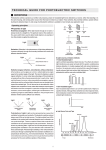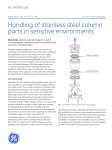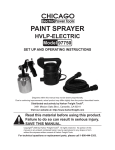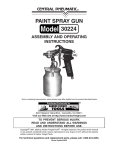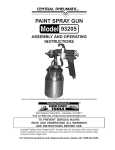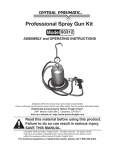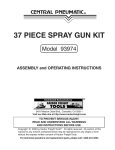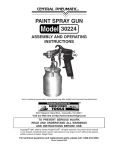Download Central Pneumatic 66871 Operating instructions
Transcript
TOUCH UP SPRAY GUN 66871 SET UP AND OPERATING INSTRUCTIONS Distributed exclusively by Harbor Freight Tools®. 3491 Mission Oaks Blvd., Camarillo, CA 93011 Visit our website at: http://www.harborfreight.com Read this material before using this product. Failure to do so can result in serious injury. SAVE THIS MANUAL. Copyright© 2009 by Harbor Freight Tools®. All rights reserved. No portion of this manual or any artwork contained herein may be reproduced in any shape or form without the express written consent of Harbor Freight Tools. Diagrams within this manual may not be drawn proportionally. Due to continuing improvements, actual product may differ slightly from the product described herein. Tools required for assembly and service may not be included. For technical questions or replacement parts, please call 1-800-444-3353. IMPORTANT: Clean the Spray Gun IMMEDIATELY after use. Improper cleaning will cause the Spray Gun not to work. CONTENTS SAFETY ALERT SYMBOL AND SIGNAL WORDS����������������������������� 3 IMPORTANT SAFETY INSTRUCTIONS�������������������������� 3 GENERAL�������������������������������������������3 WORK AREA�������������������������������������� 3 PERSONAL SAFETY������������������������� 4 OPERATING INSTRUCTIONS���� 10 TOOL SET UP���������������������������������� 10 WORK PIECE AND WORK AREA SET UP������������������������������������������ 11 GENERAL OPERATING INSTRUCTIONS���������������������������� 12 USER-MAINTENANCE INSTRUCTIONS������������������������ 13 TOOL USE AND CARE���������������������� 4 CLEANING, MAINTENANCE, AND LUBRICATION������������������������������� 13 SERVICE��������������������������������������������5 TROUBLESHOOTING���������������������� 15 AIR SOURCE�������������������������������������� 5 PARTS LIST��������������������������������� 17 SYMBOLS AND SPECIFIC SAFETY INSTRUCTIONS����������� 5 ASSEMBLY DIAGRAM���������������� 18 SYMBOL DEFINITIONS �������������������� 5 SPECIFIC SAFETY INSTRUCTIONS6 LIMITED 1 YEAR WARRANTY��� 19 FUNCTIONAL DESCRIPTION������� 8 SPECIFICATIONS������������������������������ 8 COMPONENTS AND CONTROLS���� 8 INITIAL TOOL SET UP/ ASSEMBLY���������������������������������� 8 UNPACKING��������������������������������������� 8 AIR SUPPLY��������������������������������������� 8 SKU 66871 For technical questions, please call 1-800-444-3353. Troubleshooting section near end of manual. Page 2 SAVE THIS MANUAL NOTICE is used to address practices not related to personal injury. Keep this manual for the safety warnings and precautions, assembly, operating, inspection, maintenance and cleaning procedures. Write the product’s serial number in the back of the manual near the assembly diagram (or month and year of purchase if product has no number). Keep this manual and the receipt in a safe and dry place for future reference. Safety Alert Symbol and Signal Words In this manual, on the labeling, and all other information provided with this product: This is the safety alert symbol. It is used to alert you to potential personal injury hazards. Obey all safety messages that follow this symbol to avoid possible injury or death. DANGER indicates a hazardous situation which, if not avoided, will result in death or serious injury. CAUTION, without the safety alert symbol, is used to address practices not related to personal injury. IMPORTANT SAFETY INSTRUCTIONS INSTRUCTIONS PERTAINING TO A RISK OF FIRE, ELECTRIC SHOCK, OR INJURY TO PERSONS WARNING – When using tools, basic precautions should always be followed, including the following: General a. WARNING indicates a hazardous situation which, if not avoided, could result in death or serious injury. CAUTION, used with the safety alert symbol, indicates a hazardous situation which, if not avoided, could result in minor or moderate injury. Work area a. Keep the work area clean and well lighted. Cluttered benches and dark areas increase the risks of electric shock, fire, and injury to persons. b. Do not operate the tool in explosive atmospheres, such as in the presence of flammable liquids, gases, or dust. The tool is able to create sparks resulting in the ignition of the dust or fumes. c. Keep bystanders, children, and visitors away while operating the SKU 66871 To reduce the risks of electric shock, fire, and injury to persons, read all the instructions before using the tool. For technical questions, please call 1-800-444-3353. Troubleshooting section near end of manual. Page 3 tool. Distractions are able to result in the loss of control of the tool. Personal safety a. Stay alert. Watch what you are doing and use common sense when operating the tool. Do not use the tool while tired or under the influence of drugs, alcohol, or medication. A moment of inattention while operating the tool increases the risk of injury to persons. b. Avoid unintentional starting. Be sure the trigger is released before connecting to the air supply. Do not carry the tool with your finger on the trigger or connect the tool to the air supply with the trigger depressed. c. Remove adjusting keys and wrenches before turning the tool on. A wrench or a key that is left attached to a rotating part of the tool increases the risk of personal injury. d. Do not overreach. Keep proper footing and balance at all times. Proper footing and balance enables better control of the tool in unexpected situations. e. Use safety equipment. A dust mask, non-skid safety shoes and a hard hat must be used for the applicable conditions. Wear heavy-duty work gloves during use. Tool use and care a. Use clamps or another practical way to secure and support the workpiece to a stable platform. Holding the work by hand or against the body is unstable and is able to lead to loss of control. b. Do not force the tool. Use the correct tool for the application. The correct tool will do the job better and safer at the rate for which the tool is designed. c. Do not use the tool if the trigger does not turn the tool on or off. Any tool that cannot be controlled with the trigger is dangerous and must be repaired. d. Disconnect the tool from the air source before making any adjustments, changing accessories, or storing the tool. Such preventive safety measures reduce the risk of starting the tool unintentionally. Turn off and detach the air supply, safely discharge any residual air pressure, and release the trigger before leaving the work area. e. Store the tool when it is idle out of reach of children and other untrained persons. A tool is dangerous in the hands of untrained users. f. Maintain the tool with care. Keep tools clean for better and safer performance. Follow instructions for lubricating and changing accessories. Inspect tool cords and air hoses periodically and, if damaged, have them repaired by an authorized technician. The handle must be kept clean, dry, and free from oil and grease at all times. f. Always wear eye protection. Wear ANSI-approved safety goggles. SKU 66871 For technical questions, please call 1-800-444-3353. Troubleshooting section near end of manual. Page 4 g. Disconnect air supply. Disconnect air hose when not in use, when changing accessories, and during maintenance. h. Check for misalignment or binding of moving parts, breakage of parts, and any other condition that affects the tool’s operation. If damaged, have the tool serviced before using. Many accidents are caused by poorly maintained tools. There is a risk of bursting if the tool is damaged. i. Use only accessories that are identified by the manufacturer for the specific tool model. Use of an accessory not intended for use with the specific tool model, increases the risk of injury to persons. Service a. Tool service must be performed only by qualified repair personnel. b. When servicing a tool, use only identical replacement parts. Use only authorized parts. c. Use only the lubricants supplied with the tool or specified by the manufacturer. Air source a. Never connect to an air source that is capable of exceeding 200 PSI. Over pressurizing the tool may cause bursting, abnormal operation, breakage of the tool or serious injury to persons. Use only clean, dry, regulated compressed air at the rated pressure or within the rated pressure range as marked on the tool. Always verify prior to using the tool that the SKU 66871 air source has been adjusted to the rated air pressure or within the rated air-pressure range. b. Never use oxygen, carbon dioxide, combustible gases or any bottled gas as an air source for the tool. Such gases are capable of explosion and serious injury to persons. c. Use proper size and type extension cord. If an extension cord is required for the compressor, it must be of the proper size and type to supply the correct current to the compressor without heating up. Otherwise, the extension cord could melt and catch fire, or cause electrical damage to the compressor. Check your compressor’s manual for the appropriate size cord. SAVE THESE INSTRUCTIONS. SYMBOLS AND SPECIFIC SAFETY INSTRUCTIONS Symbol Definitions Symbol Property or statement PSI Pounds per square inch of pressure CFM Cubic Feet per Minute flow SCFM Cubic Feet per Minute flow at standard conditions NPT National pipe thread, tapered NPS National pipe thread, straight Chart continued in next column. For technical questions, please call 1-800-444-3353. Troubleshooting section near end of manual. Page 5 Symbol spray guns. Many spray guns contain aluminum, which reacts strongly to chlorinated solvents. If you have any doubt about potential chemical reactions, contact the solvent or coating manufacturer. Property or statement WARNING marking concerning Risk of Eye Injury. Wear ANSI-approved eye protection. WARNING marking concerning Risk of Respiratory Injury. Wear NIOSHapproved dust mask/respirator. WARNING marking concerning Risk of Explosion. 5. Materials used when painting or cleaning may be harmful or fatal if inhaled or swallowed. Only use in an area with adequate ventilation. Use a NIOSH-approved respirator when painting or using cleaning solvents. 6. Do not release spray gun lid while cup is pressurized. 7. Industrial applications must follow OSHA requirements. 8. Do not point a spray gun at a person or animal. Serious injury could occur. 9. Spraying hazardous materials may result in serious injury or death. Do not spray pesticides, acids, corrosive materials, fertilizers, and toxic chemicals. WARNING marking concerning Risk of Fire. Specific Safety Instructions 1. 2. Thoroughly clean the spray gun out after every use. Improper cleaning of the Spray Gun is a common reason for the Spray Gun to jam or not perform properly. The warnings and precautions discussed in this manual cannot cover all possible conditions and situations that may occur. It must be understood by the operator that common sense and caution are factors which cannot be built into this product, but must be supplied by the operator. 3. Do not spray near open flames, pilot lights, stoves, heaters, the air compressor, or any other heat source. Most solvents and coatings are highly flammable, particularly when sprayed. Maintain a distance of at least 25 feet from the air compressor. If possible, locate the air compressor in a separate room. 4. Read all of the information concerning coating products and cleaning solvents. Do not use chlorinated solvents (e.g. 1-1-1 Trichlorethylene and Methylene Choride, also know as methyl chloride) to clean SKU 66871 10. WARNING: Some dust created by power sanding, sawing, grinding, drilling, and other construction activities, contains chemicals known [to the State of California] to cause cancer, birth defects or other reproductive harm. Some examples of these chemicals are: • Lead from lead-based paints • Crystalline silica from bricks and cement or other masonry products • Arsenic and chromium from chemically treated lumber Your risk from these exposures varies, depending on how often you do this type of work. To reduce your exposure to these chemicals: work in a well ventilated area, and work with For technical questions, please call 1-800-444-3353. Troubleshooting section near end of manual. Page 6 approved safety equipment, such as those dust masks that are specially designed to filter out microscopic particles. (California Health & Safety Code § 25249.5, et seq.) WARNING: The brass components of this product contain lead, a chemical known to the State of California to cause birth defects (or other reproductive harm). (California Health & Safety code § 25249.5, et seq.) 11. Attach all accessories properly to the tool before connecting the air supply. A loose accessory may detach or break during operation. 12. Obey the manual for the air compressor used to power this tool. 13. Install an in-line shutoff valve to allow immediate control over the air supply in an emergency, even if a hose is ruptured. Note Performance of the compressor (if powered by line voltage) may vary depending on variations in local line voltage. Extension cord usage may also affect tool performance. SAVE THESE INSTRUCTIONS. SKU 66871 For technical questions, please call 1-800-444-3353. Troubleshooting section near end of manual. Page 7 refer to the Assembly Diagram near the end of this manual. FUNCTIONAL DESCRIPTION Specifications Unpacking Operating Air Pressure 45-60 PSI Paint Capacity 6.75 fluid oz Air Inlet 1/4” - 18 NPS Nozzle Size .06” (1.5 mm) Feed Type Siphon Air Consumption 4.7 CFM @ 45 PSI 6.2 CFM @ 60 PSI When unpacking, make sure that the item is intact and undamaged. If any parts are missing or broken, please call Harbor Freight Tools at 1-800-444-3353 as soon as possible. • This spray gun may be shipped with a protective plug covering the air inlet. Remove this plug before set up. Components and Controls Trigger Pattern Control Knob Cup Locking Yoke Air Supply Air Inlet Air Cap Set Cup Locking Lever TO PREVENT EXPLOSION: Use only clean, dry, regulated, compressed air to power this spray gun. Do not use oxygen, carbon dioxide, combustible gases, or any other bottled gas as a power source for this spray gun. Fluid Control Knob Coupler Plug Cup Vent Coupler Plug Tool Cup Quick Coupler INITIAL TOOL SET UP/ ASSEMBLY Read the ENTIRE IMPORTANT SAFETY INFORMATION section at the beginning of this manual including all text under subheadings therein before set up or use of this product. Note: For additional information regarding the parts listed in the following pages, SKU 66871 Valve Dryer Air Hose on Reel Filter Air Compressor Quick Coupler Regulator with Pressure Gauge Recommended Air Line Components 1. Incorporate a filter, regulator with pressure gauge, dryer, in-line shutoff valve, and quick coupler for best ser- For technical questions, please call 1-800-444-3353. Troubleshooting section near end of manual. Page 8 vice, as shown in the diagram above. An in-line shutoff ball valve is an important safety device because it controls the air supply even if the air hose is ruptured. The shutoff valve should be a ball valve because it can be closed quickly. allow it to build up pressure until it cycles off. 7. Adjust the air compressor’s output regulator so that the air output is enough to properly power the spray gun, but the output will not exceed the spray gun’s Operating Air Pressure at any time. Adjust the pressure gradually, while checking the air output gauge to set the right pressure range. 8. Inspect the air connections for leaks. Repair any leaks found. 9. If the spray gun will not be used at this time, turn off and detach the air supply, safely discharge any residual air pressure, and release the trigger to prevent accidental operation. Note: An oiler system should not be used with this spray gun. The oil will mix with the material being propelled, causing poor results. 2. Attach an air hose to the compressor’s air outlet. Connect the air hose to the Air Inlet of the spray gun. Other components, such as a coupler plug and quick coupler, will make operation more efficient, but are not required. WARNING! TO PREVENT SERIOUS INJURY FROM ACCIDENTAL OPERATION: Do not install a FEMALE quick coupler on the spray gun. Such a coupler contains an air valve that will allow the spray gun to retain pressure and operate accidentally after the air supply is disconnected. Note: Residual air pressure should not be present after the spray gun is disconnected from the air supply. However, it is a good safety measure to attempt to discharge the spray gun in a safe fashion after disconnecting to ensure that the spray gun is disconnected and unpowered. Note: Air flow, and therefore spray gun performance, can be hindered by undersized air supply components. 3. The air hose must be long enough to reach the work area with enough extra length to allow free movement while working. 4. Release the spray gun’s Trigger. 5. Close the in-line safety Valve between the compressor and the spray gun. 6. Turn on the air compressor according to the manufacturer’s directions and SKU 66871 For technical questions, please call 1-800-444-3353. Troubleshooting section near end of manual. Page 9 IMPORTANT: Clean the Spray Gun IMMEDIATELY after use. Improper cleaning will cause the Spray Gun not to work. OPERATING INSTRUCTIONS Read the ENTIRE IMPORTANT SAFETY INFORMATION section at the beginning of this manual including all text under subheadings therein before set up or use of this product. Inspect spray gun before use, looking for damaged, loose, and missing parts. If any problems are found, do not use spray gun until repaired. Tool Set Up TO PREVENT SERIOUS INJURY FROM ACCIDENTAL OPERATION: Detach the air supply, safely discharge any residual air pressure in the spray gun, and release the trigger before performing any inspection, maintenance, or cleaning procedures. Material Preparation and filling Note: Proper paint material mixture helps to ensure less problems. Follow the manufacturer’s directions. Most materials will spray readily if they are thinned properly. 1. Mix and thin the paint/materials thoroughly according to the manufacturer’s directions. 2. Carefully strain the paint/material through a paint strainer or piece of cheese cloth. SKU 66871 Cup Locking Yoke Cup Locking Lever Cup 3. Move the Cup Locking Lever clockwise until the cup is released. 4. Fill the Cup to approximately 3/4 full. 5. Replace the Spray Gun on the Cup. 6. Hook the Cup Locking Yoke over the tabs on the cup. Move the Cup Locking Lever counterclockwise until snug. DO NOT FORCE THE LEVER! 7. Start the air compressor. 8. To adjust the spray pattern, set up a piece of scrap material to practice on. While practicing on the scrap material, check to see that the material you are spraying has the appropriate consistency. If it appears too thin, add a very small amount of thinner (not included). Use the proper thinner for the type of paint you are using. BE CAREFUL when thinning. Proceed slowly, adding very minimal amounts. DO NOT exceed the manufacturer’s thinning recommendations. For technical questions, please call 1-800-444-3353. Troubleshooting section near end of manual. Page 10 IMPORTANT: Clean the Spray Gun IMMEDIATELY after use. Improper cleaning will cause the Spray Gun not to work. Fan Direction Lock Ring Horizontal Fan Air Cap pattern. Turn it Clockwise for a round spray pattern - see Figure 2. 3. Turn the Fluid Control Knob clockwise until it is fully closed. 4. After setting up a piece of scrap material, squeeze the Trigger in short bursts while tuning the Fluid Control Knob counterclockwise and observe the spray patterns until you see the pattern you want. Vertical Fan Figure 1 1. 2. To change the direction of the fan from horizontal to vertical, loosen the Lock Ring and turn the Air Cap 90° See Figure 1. After the adjustment, tighten the Lock Ring by hand. Too Coarse (Decrease fluid flow) 5. Pattern Adjustment WARNING! Do not exceed the Operating Air Pressure shown on the Specification chart. 1. Adjust the air pressure during operation with the Trigger fully depressed. If you need to reduce the air pressure for specific areas, adjust the air supply pressure. Round/Closed Flat/Open Figure 2 2. Use the Pattern Control Knob to adjust the spray pattern. Turn the Pattern Control Knob counterclockwise (all the way open) to flatten the spray SKU 66871 Correct Too Fine (Increase fluid flow) Also, look at the pattern for consistency - see above. Too much air may cause the spray to come out too fine. Reduce the air pressure or allow more material to come out by opening the Fluid Control Knob. If the spray appears too thick (you see globs of paint), close down the Fluid Control Knob slowly, checking the mixture after each adjustment. Work Piece and Work Area Set Up 1. Designate a work area that is clean and well-lit. The work area must not allow access by children or pets to prevent injury and distraction. 2. Route the air hose along a safe route to reach the work area without creating a tripping hazard or exposing the air hose to possible damage. The air hose must be long enough to reach the work area with enough extra length to allow free movement while working. For technical questions, please call 1-800-444-3353. Troubleshooting section near end of manual. Page 11 IMPORTANT: Clean the Spray Gun IMMEDIATELY after use. Improper cleaning will cause the Spray Gun not to work. the Trigger. When you are finished spraying, release the Trigger before you stop moving the Spray Gun. Doing so will eliminate distinct overlaps, producing a blended (feathered) affect - See Figure 4. General Operating Instructions Note: Before spraying, mask all objects you do not want sprayed and lay cloths (not included) on the floors. Incorrect (Heavier coat on one side = uneven coverage) Correct (90°) (Even coverage) Figure 3 1. Keep the spray gun at a right angle to the workpiece - See Figure 3. 2. Pull the Trigger slowly and move the Spray Gun in parallel strokes to the object being painted. Keep the distance from the object being painted at 6” to 9”. This may slightly differ depending on the flow adjustment and the material being sprayed. Do not stop the spray gun movement while spraying. If you stop the spray gun for even just a slight pause while spraying, the paint will build up and run down the workpiece. Begin Stroke Squeeze Trigger Release Trigger Note: The speed of the stroke, the adjustment of the Fluid Control Knob, and the distance from the workpiece, will determine how much paint is being applied. To get the best results, try to apply two thin coats of paint versus one thick coat. 4. Do not block the Cup Vent. Keep the Spray Gun upright. 5. To prevent accidents, release the trigger, detach the air supply, safely discharge any residual air pressure in the spray gun, and release the trigger after use. 6. Clean out the spray gun thoroughly immediately after EVERY use, according to the instructions found on the next pages. End Stroke Figure 4 (Top View) 3. To avoid paint build up, start moving the Spray Gun before you squeeze SKU 66871 For technical questions, please call 1-800-444-3353. Troubleshooting section near end of manual. Page 12 IMPORTANT: Clean the Spray Gun IMMEDIATELY after use. Improper cleaning will cause the Spray Gun not to work properly. Materials dry quickly which will render the gun useless. It is extremely difficult to remove dry paint from small passages within the Gun. USER-MAINTENANCE INSTRUCTIONS Procedures not specifically explained in this manual must be performed only by a qualified technician. TO PREVENT SERIOUS INJURY FROM ACCIDENTAL OPERATION: Detach the air supply, safely discharge any residual air pressure in the tool, and release the trigger before performing any inspection, maintenance, or cleaning procedures. TO PREVENT SERIOUS INJURY FROM TOOL FAILURE: Do not use damaged equipment. If abnormal noise, vibration, or leaking air occurs, have the problem corrected before further use. Cleaning, Maintenance, and Lubrication Note: These procedures are in addition to the regular checks and maintenance explained as part of the regular operation of the air-operated tool. 1. IMPORTANT: Do not use mineral spirits on latex paints or the mixture will congeal, making it very difficult to remove. 2. SKU 66871 Oil Based Paints: Use mineral spirits. WARNING! TO PREVENT FIRE, IF A FLAMMABLE SOLVENT NEEDS TO BE USED, ADHERE TO THE FOLLOWING: 3. Follow all of the solvent manufacturer’s clean up instructions and safety precautions at all times. 4. Flush the Spray Gun a full hose length from the air compressor. 5. If collecting flushed solvents into a metal container, transfer into a large nonmetal container, and flush the metal container. 6. Work far away from any ignition sources in a vapor free area. After each use: 1. Empty the Paint Cup and clean it with the solvent. 2. Fill the Paint Cup with solvent and spray it through the Spray Gun into a container, while shaking the spray gun. Once the Paint Cup is empty, repeat the process until the solvent comes out clean. 3. Disconnect from the air source. Solvent Selection Follow the paint manufacturer’s recommendations for cleaning, solvent type, and disposing of used solvent. Latex Paints: Use warm, soapy water. For technical questions, please call 1-800-444-3353. Troubleshooting section near end of manual. Page 13 IMPORTANT: Clean the Spray Gun IMMEDIATELY after use. Improper cleaning will cause the Spray Gun not to work properly. Materials dry quickly which will render the gun useless. It is extremely difficult to remove dry paint from small passages within the Gun. 4. 5. After disconnecting, be aware that air pressure may still remain in the Spray Gun. Point the Spray Gun into the spent solvent container and squeeze the Trigger again to make sure no air remains. Daily - Air Supply Maintenance Every day, perform maintenance on the air supply according to the component manufacturers’ instructions. Remove the Air Cap and soak it in solvent until it is clean. Use an old toothbrush and toothpicks to remove any material. Note: Do not use metal objects to clean the Air Cap or you may damage the drilled passages. 6. Inspect the fluid needle and make sure it is not bent. If it is bent, have it replaced by a qualified service technician. CAUTION: Do not immerse the Spray Gun Body in solvent. 7. Use the appropriate solvent (depending on the material sprayed) to wipe down the Spray Gun body. 8. Lubricate the Spray Gun after cleaning. You may use a non-silicon oil or a light lubricant on all threaded connections prior to storing the unit. Solution Disposal After cleaning your Spray Gun, properly dispose of your cleaning solutions according to the solution manufacturer’s directions and local hazardous waste standards. SKU 66871 For technical questions, please call 1-800-444-3353. Troubleshooting section near end of manual. Page 14 IMPORTANT: The Spray Gun must be cleaned immediately after use. Improper cleaning is a common reason for the Spray Gun not to work. Troubleshooting Spray Pattern Diagnosis The drawings on the left below resemble symptoms of spray pattern problems. Please refer to the accompanying possible problems and solutions if you are experiencing similar difficulties. Problem Possible Causes 1. The Pattern Control Knob is partially closed. 2. The material is too thick. 3. The air pressure is too low. Likely Solutions 1. Open Pattern Control Knob. 2. Thin material according to the manufacturer’s instructions. 3. Increase air pressure within the Operating Air Pressure shown on Specification chart. 1. High air pressure. 2. Not enough fluid. 3. Pattern Control Knob open too much. 1. Reduce air pressure. 2. Increase fluid. 3. Partially close Pattern Control Knob. 1. Air Cap plugged. 2. Air Cap loose or dirty seal. 3. Dried material on fluid tip. 1. Clean the Air Cap. 2. Clean and tighten Air Cap and seal. 3. Use a nonmetallic point to clean the Air Cap. 1. Dirt on one side of the fluid tip. 2. Holes on one side of the Air Cap are plugged. 1. Clean fluid tip. 2. Clean the Air Cap with a nonmetallic point. Follow all safety precautions whenever diagnosing or servicing the tool. Disconnect air supply before service. If the steps above do not solve the problem or if the repairs involved are too complex, contact a qualified technician. SKU 66871 For technical questions, please call 1-800-444-3353. Page 15 IMPORTANT: The Spray Gun must be cleaned immediately after use. Improper cleaning is a common reason for the Spray Gun not to work. Troubleshooting (continued) Problem Sputtering Spray Will Not Spray Possible Causes 1. Low material level. 2. Cup tipped too far. 3. Clogged Air Vent. 4. Loose fluid inlet connections. 5. Dry or loose fluid needle Packing Nut. 6. Loose/damaged fluid tip/seat. 1. No pressure at spray gun. 2. Fluid control not open enough. 3. Fluid too thick. 1. Improper application speed. 2. Improper distance from workpiece. 3. Too much air pressure. Fluid Tip Leakage 1. Dirty tip. 2. Tight Packing Nut. 3. Broken fluid needle spring. 4. Worn or damaged tip. Air Leaking from 1. Dirty air valve/seat. Air Cap 2. Sticking air valve. 3. Damaged air valve spring. 4. Worn/damaged air valve/seat. 5. Bent valve stem. 1. Packing Nut Loose. Fluid Leaking from Packing Nut 2. Packing worn or dry. Overspray Likely Solutions 1. Refill. 2. Hold upright. 3. Clean vent hole. 4. Tighten inlet connections. 5. Lubricate and/or tighten fluid needle Packing Nut. 6. Adjust or replace fluid tip. 1. Check air hoses. 2. Open fluid control. 3. Thin fluid or increase air pressure (within Operating Air Pressure). 1. Move moderately and parallel. 2. Adjust distance. 3. Reduce air pressure. 1. Clean tip. 2. Loosen Packing Nut. 3. Replace fluid needle spring. 4. Replace tip and/or needle. 1. Clean air valve/seat. 2. Lubricate air valve/seat. 3. Replace air valve spring. 4. Replace air valve. 5. Replace air valve. 1. Tighten without restricting. 2. Replace or lubricate (non-silicone) Follow all safety precautions whenever diagnosing or servicing the tool. Disconnect air supply before service. If the steps above do not solve the problem or if the repairs involved are too complex, contact a qualified technician. SKU 66871 For technical questions, please call 1-800-444-3353. Page 16 PLEASE READ THE FOLLOWING CAREFULLY THE MANUFACTURER AND/OR DISTRIBUTOR HAS PROVIDED THE PARTS LIST AND ASSEMBLY DIAGRAM IN THIS MANUAL AS A REFERENCE TOOL ONLY. NEITHER THE MANUFACTURER OR DISTRIBUTOR MAKES ANY REPRESENTATION OR WARRANTY OF ANY KIND TO THE BUYER THAT HE OR SHE IS QUALIFIED TO MAKE ANY REPAIRS TO THE PRODUCT, OR THAT HE OR SHE IS QUALIFIED TO REPLACE ANY PARTS OF THE PRODUCT. IN FACT, THE MANUFACTURER AND/ OR DISTRIBUTOR EXPRESSLY STATES THAT ALL REPAIRS AND PARTS REPLACEMENTS SHOULD BE UNDERTAKEN BY CERTIFIED AND LICENSED TECHNICIANS, AND NOT BY THE BUYER. THE BUYER ASSUMES ALL RISK AND LIABILITY ARISING OUT OF HIS OR HER REPAIRS TO THE ORIGINAL PRODUCT OR REPLACEMENT PARTS THERETO, OR ARISING OUT OF HIS OR HER INSTALLATION OF REPLACEMENT PARTS THERETO. PARTS LIST Part Description Part Description 1 Container cup set 11 O-ring 2 Gun Body 12 Trigger 3 Gun body set 13 Trigger pin 4 Fluid needle set 14 Pattern adj. set 5 Spring 15 Fluid nozzle 6 Fluid adj. Knob 16 Air cup set 7 Air inlet plug 17 Sealing ring 8 O-ring 18 Directional Screw 9 Spring 19 Paint inlet joint 10 Air valve seat SKU 66871 For technical questions, please call 1-800-444-3353. Page 17 ASSEMBLY DIAGRAM 14 16 13 12 11 10 9 8 7 15 17 18 4 19 1 2 5 6 3 Record Product’s Serial Number Here: Note: If product has no serial number, record month and year of purchase instead. Note: Some parts are listed and shown for illustration purposes only, and are not available individually as replacement parts. SKU 66871 For technical questions, please call 1-800-444-3353. Page 18 90 Day Warranty Harbor Freight Tools Co. makes every effort to assure that its products meet high quality and durability standards, and warrants to the original purchaser that this product is free from defects in materials and workmanship for the period of 90 days from the date of purchase. This warranty does not apply to damage due directly or indirectly, to misuse, abuse, negligence or accidents, repairs or alterations outside our facilities, criminal activity, improper installation, normal wear and tear, or to lack of maintenance. We shall in no event be liable for death, injuries to persons or property, or for incidental, contingent, special or consequential damages arising from the use of our product. Some states do not allow the exclusion or limitation of incidental or consequential damages, so the above limitation of exclusion may not apply to you. THIS WARRANTY IS EXPRESSLY IN LIEU OF ALL OTHER WARRANTIES, EXPRESS OR IMPLIED, INCLUDING THE WARRANTIES OF MERCHANTABILITY AND FITNESS. To take advantage of this warranty, the product or part must be returned to us with transportation charges prepaid. Proof of purchase date and an explanation of the complaint must accompany the merchandise. If our inspection verifies the defect, we will either repair or replace the product at our election or we may elect to refund the purchase price if we cannot readily and quickly provide you with a replacement. We will return repaired products at our expense, but if we determine there is no defect, or that the defect resulted from causes not within the scope of our warranty, then you must bear the cost of returning the product. This warranty gives you specific legal rights and you may also have other rights which vary from state to state. 3491 Mission Oaks Blvd. • PO Box 6009 • Camarillo, CA 93011 • (800) 444-3353 SKU 66871 For technical questions, please call 1-800-444-3353. Page 19




















